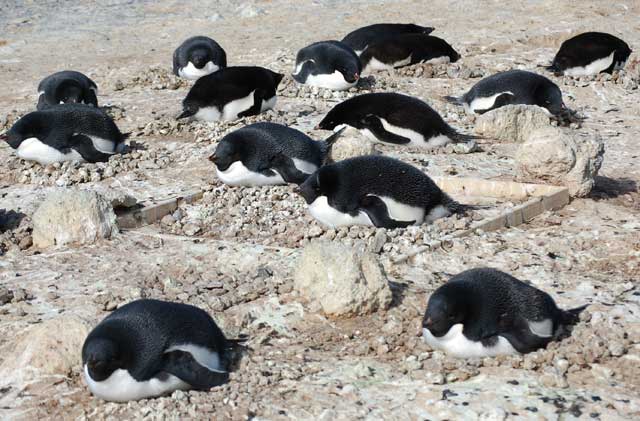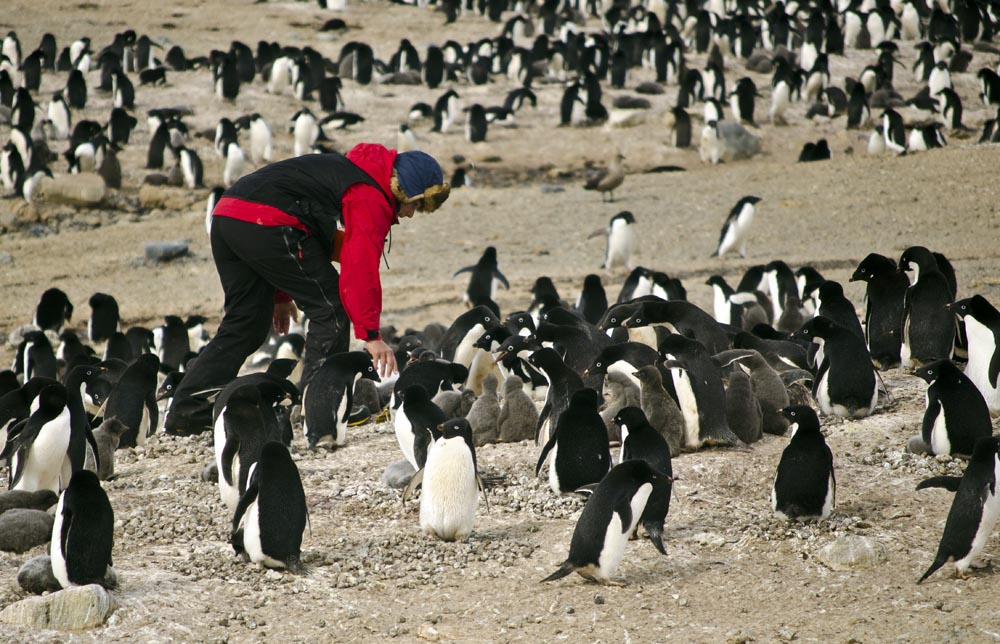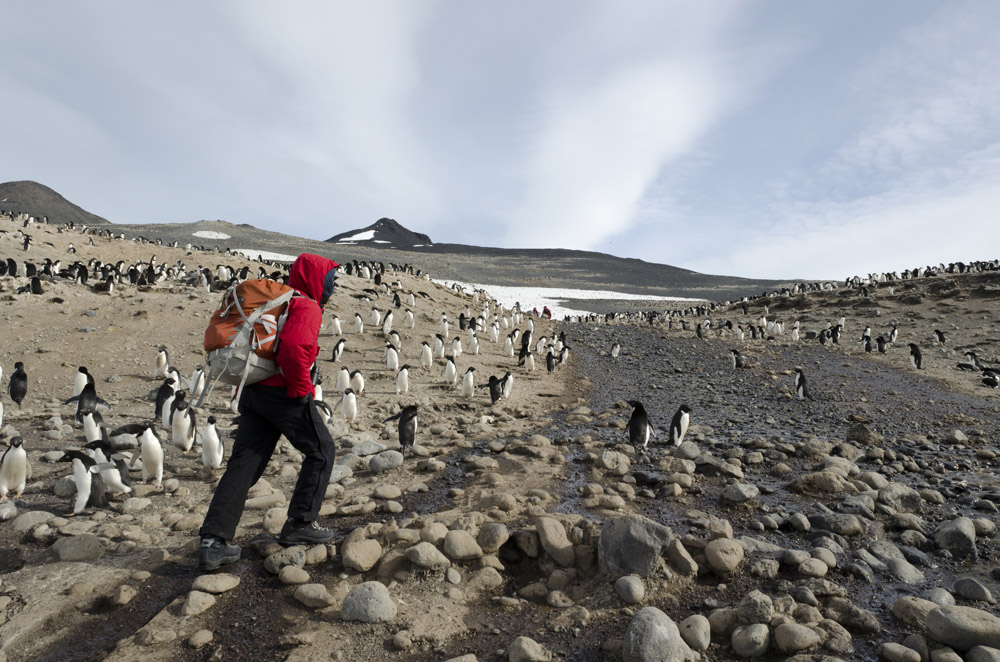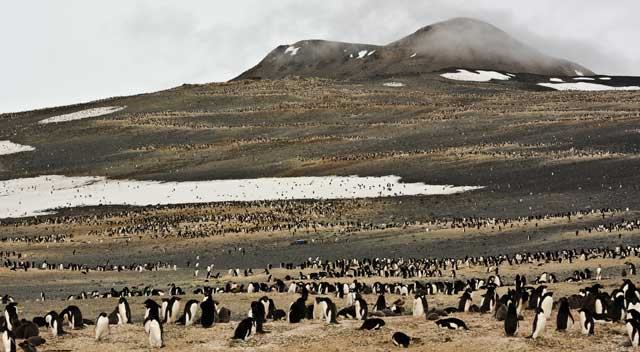|
Infectious researchVirus found among Adélie penguin population on Ross IslandPosted June 6, 2014
It seems that research into Antarctic penguins and viruses has gone, well, viral. A team of researchers funded by the National Science Foundation The former finding, published in the Journal of General Virology earlier this year, is the first report of a papillomavirus associated with a penguin species. Only three papillomaviruses have previously been identified in birds, though there are hundreds of types, including many that infect humans. “I was not expecting to find an avian papillomavirus to be honest,” said lead author Arvind Varsani 
Photo Credit: Jean Pennycook
A box is used to collect penguin guano. Samples were analyzed for the virus study. However, the researchers primarily collect
penguin poo to collect fish otoliths, or ear bones, that pass through the penguins'
digestive system to keep tabs on the sorts of fish the penguins are eating (mainly Antarctic silverfish).
“I thought what we’d find would be novel viruses that are highly divergent from any known viruses,” he explained via e-mail. “The Antarctic ecosystem is quite unique, and hence I imagined that the viruses found there would probably require the establishment of new viral families to accommodate these viruses.” Papillomaviruses (PV) typically infect the skin or mucus membranes in most vertebrate species. Human PV types can cause benign warts, though types that are more serious can become cancerous. Varsani said the scientists have no idea if the Adélie papillomavirus is benign or not. “To be honest, I’d say we [know] extremely little about viruses associated with penguins,” Varsani said. The handful of previous studies on viruses associated with penguin species relied on serology, using blood samples to identify the specific antibodies associated with certain types of viruses. The current studies rely on genetic techniques. In the research led by Varsani, the team used a noninvasive technique, collecting fecal matter, and then extracted the total viral DNA, followed by DNA sequencing and database searches to determine the entire genome of the virus. Varsani said there are several important reasons for studying viruses in penguins, not least of which is to establish a baseline on virology in Antarctica, which is the least studied of the continents in this field. Research will also allow scientists to identify emerging viruses, especially those that may appear as the climate changes. “Viruses are everywhere and infect organisms in every domain of life,” Varsani said. “With habitat loss we are bound to see a higher incidence of emerging viruses that will spill over from well-established ecosystems to ‘altered’ ecosystems.” 
Photo Credit: Peter Rejcek
Melanie Massaro, a scientist at Charles Sturt University in Australia, works on penguin physiology and was a co-author on the virus study.
Varsani is also collaborating with other U.S. Antarctic Program “This opens up some important questions about pathogens in the Antarctic, including flow of pathogens from sled dogs to seals,” Varsani said, referring to a real concern that led to the eventual banishment of canines from Antarctica in 1994, “or as a matter of fact from any organism to another. [It] also raises a serious question with climate change: are the current ecosystems being seeded with pathogens trapped in the last glacial ice age?” During the 2011-12 season, before Varsani joined the team, researchers had noted a high incidence of what looked like “beak-and-feather” disease, according to David Ainley The suspected virus, which is known to affect parrots, caused the loss of feathers mainly around the birds’ faces and bills across about 10 percent of the penguins. The next year, it was mostly gone, said Ainley, senior ecologist at a San Francisco Bay Area ecological consulting firm, H.T. Harvey and Associates Tests on blood samples collected from the birds for other studies related to the individual fitness and breeding success of some Adélies over others were inconclusive. “There has been evidence of very low presence of whatever it was since,” Ainley added, saying less than 1 percent of the population still seems to be affected. In the study that discovered avian influenza among the Adélie penguins of the Antarctic Peninsula – published in mBio, the online open-access journal of the American Society for Microbiology “We found that this virus was unlike anything else detected in the world,” said lead author Aeron Hurt Like the rapidly evolving viruses themselves, the study of virology in the Antarctic appears to be evolving rapidly. A preprint version of a paper in the journal Infection, Genetics and Evolution by Peyman Zawar-Reza et al, a study led by Varsani, reported identifying eight novel viruses from algal mats found in a freshwater pond on the McMurdo Ice Shelf sampled in 1988 by Paul Broady Varsani said more papers are forthcoming on other novel viruses discovered among the penguin populations and melting permafrost in the Dry Valleys. “We are living in a rapidly changing environment, as a result of climate change and human activities (some of our negative impacts on ecosystems including deforestation, over fishing, pollution, etc.),” Varsani said. “These have huge implications on pathogen evolution and spread.” NSF-funded research in this story: David Ainley, H.T. Harvey and Associates, Award No. 0944411 |



For USAP Participants |
For The Public |
For Researchers and EducatorsContact UsU.S. National Science FoundationOffice of Polar Programs Geosciences Directorate 2415 Eisenhower Avenue, Suite W7100 Alexandria, VA 22314 Sign up for the NSF Office of Polar Programs newsletter and events. Feedback Form |



